Chronic Heart Failure Research Summary
VerifiedAdded on 2020/01/21
|14
|3950
|95
AI Summary
This assignment presents a summary of various research articles focused on chronic heart failure. The research explores the impact of exercise training on endothelial function and regeneration in aging patients with chronic heart failure. It also examines the relationship between body mass index and mortality in these patients, as well as the effectiveness of intermittent versus continuous exercise training. Finally, the document delves into biomarkers like galectin-3 and soluble ST2 for diagnosing and monitoring chronic heart failure.
Contribute Materials
Your contribution can guide someone’s learning journey. Share your
documents today.
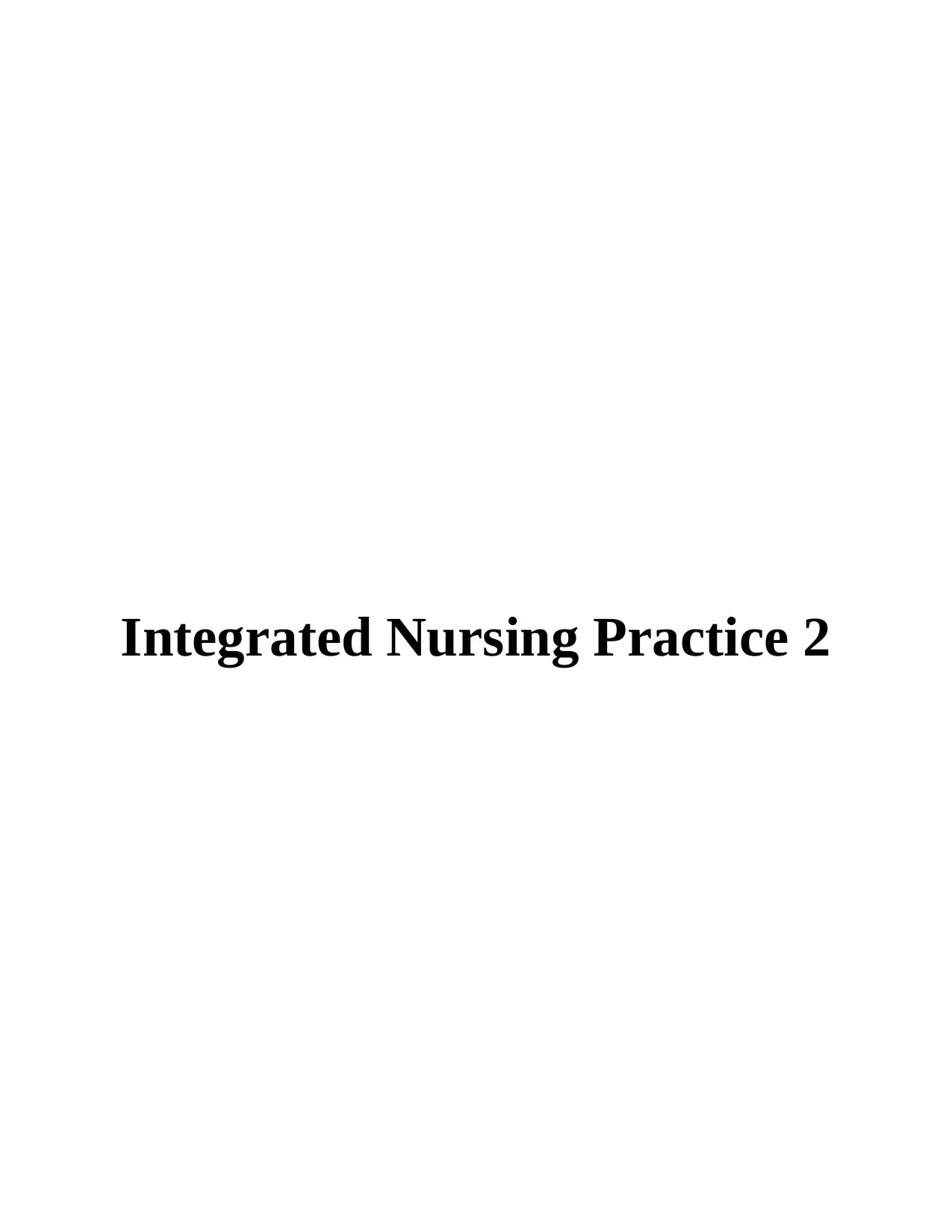
Integrated Nursing Practice 2
Secure Best Marks with AI Grader
Need help grading? Try our AI Grader for instant feedback on your assignments.
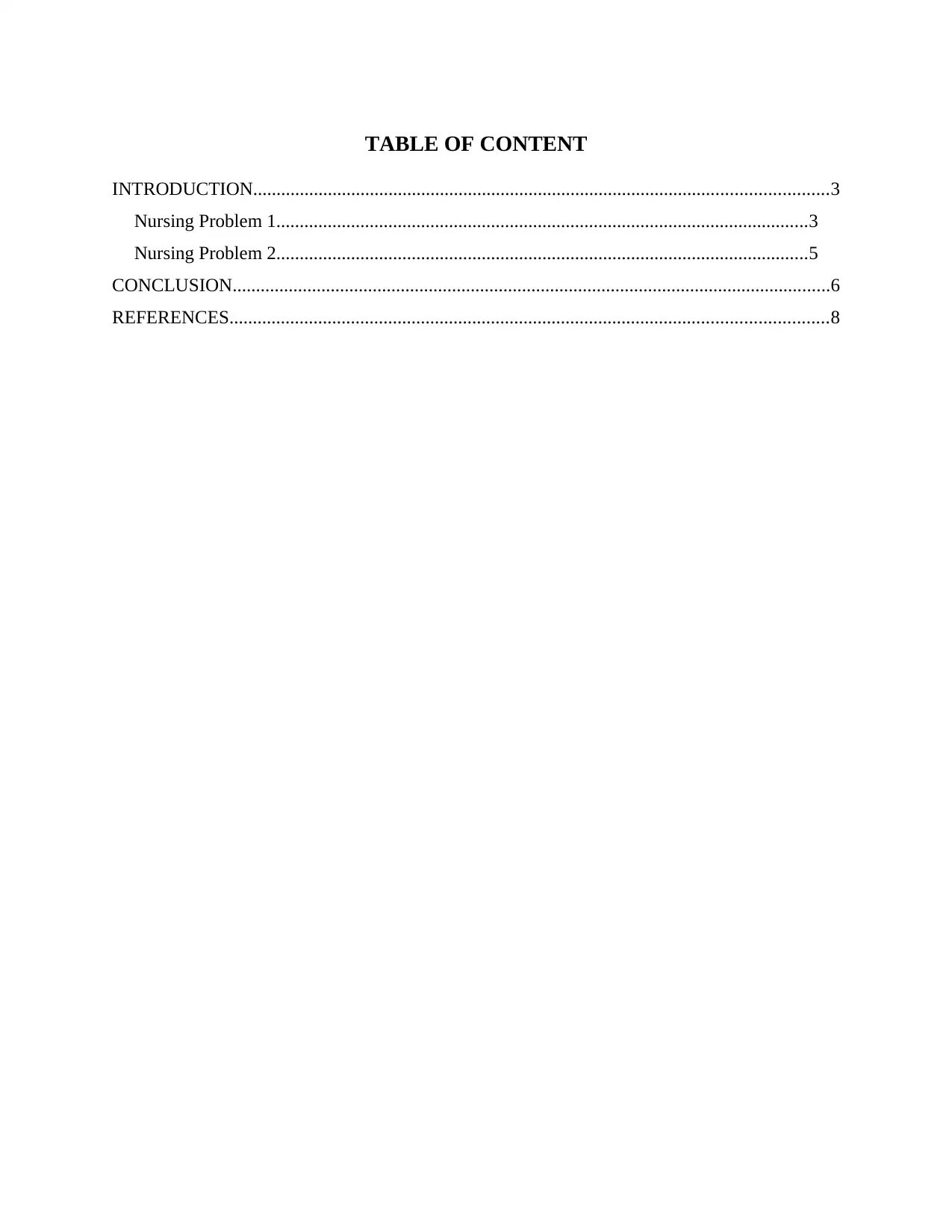
TABLE OF CONTENT
INTRODUCTION...........................................................................................................................3
Nursing Problem 1..................................................................................................................3
Nursing Problem 2..................................................................................................................5
CONCLUSION................................................................................................................................6
REFERENCES................................................................................................................................8
INTRODUCTION...........................................................................................................................3
Nursing Problem 1..................................................................................................................3
Nursing Problem 2..................................................................................................................5
CONCLUSION................................................................................................................................6
REFERENCES................................................................................................................................8
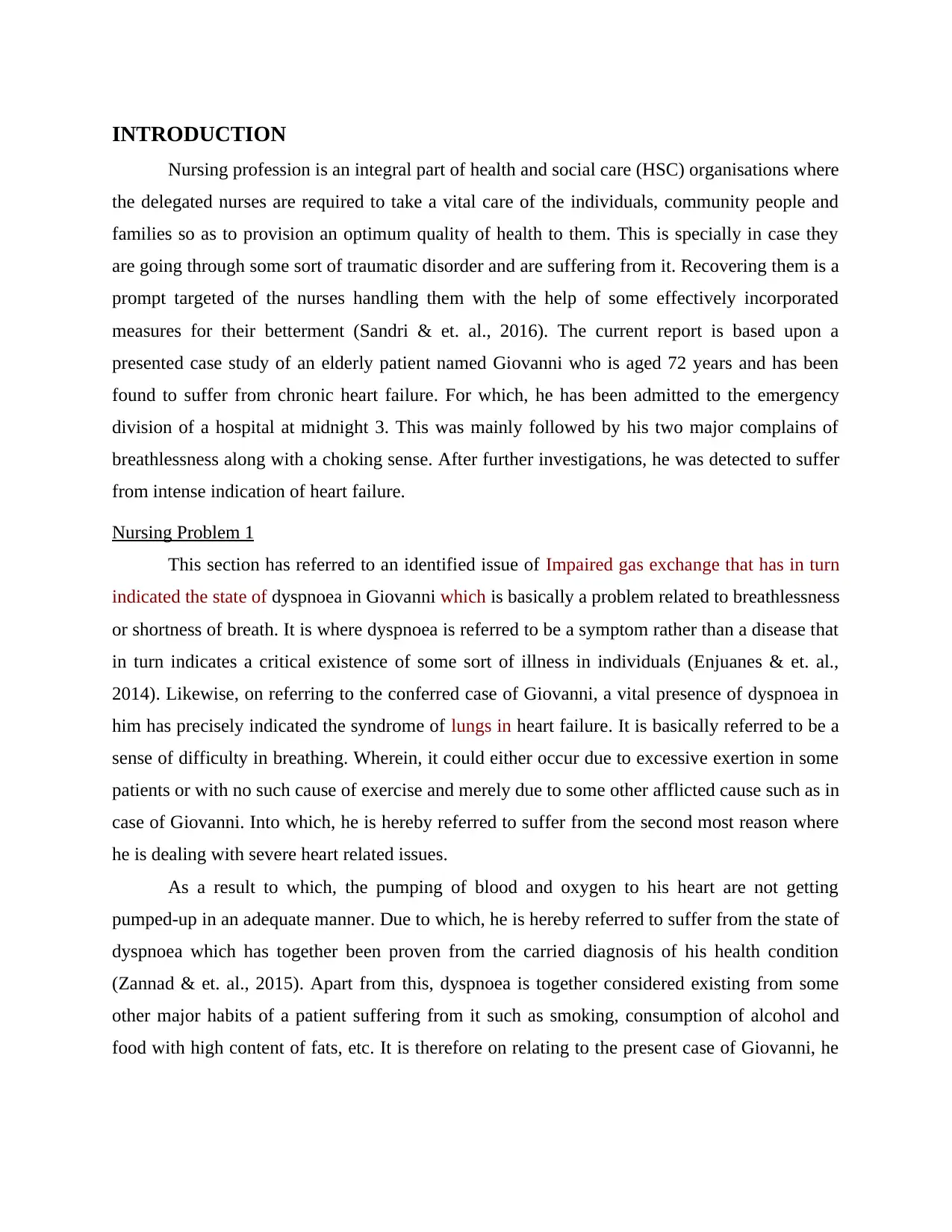
INTRODUCTION
Nursing profession is an integral part of health and social care (HSC) organisations where
the delegated nurses are required to take a vital care of the individuals, community people and
families so as to provision an optimum quality of health to them. This is specially in case they
are going through some sort of traumatic disorder and are suffering from it. Recovering them is a
prompt targeted of the nurses handling them with the help of some effectively incorporated
measures for their betterment (Sandri & et. al., 2016). The current report is based upon a
presented case study of an elderly patient named Giovanni who is aged 72 years and has been
found to suffer from chronic heart failure. For which, he has been admitted to the emergency
division of a hospital at midnight 3. This was mainly followed by his two major complains of
breathlessness along with a choking sense. After further investigations, he was detected to suffer
from intense indication of heart failure.
Nursing Problem 1
This section has referred to an identified issue of Impaired gas exchange that has in turn
indicated the state of dyspnoea in Giovanni which is basically a problem related to breathlessness
or shortness of breath. It is where dyspnoea is referred to be a symptom rather than a disease that
in turn indicates a critical existence of some sort of illness in individuals (Enjuanes & et. al.,
2014). Likewise, on referring to the conferred case of Giovanni, a vital presence of dyspnoea in
him has precisely indicated the syndrome of lungs in heart failure. It is basically referred to be a
sense of difficulty in breathing. Wherein, it could either occur due to excessive exertion in some
patients or with no such cause of exercise and merely due to some other afflicted cause such as in
case of Giovanni. Into which, he is hereby referred to suffer from the second most reason where
he is dealing with severe heart related issues.
As a result to which, the pumping of blood and oxygen to his heart are not getting
pumped-up in an adequate manner. Due to which, he is hereby referred to suffer from the state of
dyspnoea which has together been proven from the carried diagnosis of his health condition
(Zannad & et. al., 2015). Apart from this, dyspnoea is together considered existing from some
other major habits of a patient suffering from it such as smoking, consumption of alcohol and
food with high content of fats, etc. It is therefore on relating to the present case of Giovanni, he
Nursing profession is an integral part of health and social care (HSC) organisations where
the delegated nurses are required to take a vital care of the individuals, community people and
families so as to provision an optimum quality of health to them. This is specially in case they
are going through some sort of traumatic disorder and are suffering from it. Recovering them is a
prompt targeted of the nurses handling them with the help of some effectively incorporated
measures for their betterment (Sandri & et. al., 2016). The current report is based upon a
presented case study of an elderly patient named Giovanni who is aged 72 years and has been
found to suffer from chronic heart failure. For which, he has been admitted to the emergency
division of a hospital at midnight 3. This was mainly followed by his two major complains of
breathlessness along with a choking sense. After further investigations, he was detected to suffer
from intense indication of heart failure.
Nursing Problem 1
This section has referred to an identified issue of Impaired gas exchange that has in turn
indicated the state of dyspnoea in Giovanni which is basically a problem related to breathlessness
or shortness of breath. It is where dyspnoea is referred to be a symptom rather than a disease that
in turn indicates a critical existence of some sort of illness in individuals (Enjuanes & et. al.,
2014). Likewise, on referring to the conferred case of Giovanni, a vital presence of dyspnoea in
him has precisely indicated the syndrome of lungs in heart failure. It is basically referred to be a
sense of difficulty in breathing. Wherein, it could either occur due to excessive exertion in some
patients or with no such cause of exercise and merely due to some other afflicted cause such as in
case of Giovanni. Into which, he is hereby referred to suffer from the second most reason where
he is dealing with severe heart related issues.
As a result to which, the pumping of blood and oxygen to his heart are not getting
pumped-up in an adequate manner. Due to which, he is hereby referred to suffer from the state of
dyspnoea which has together been proven from the carried diagnosis of his health condition
(Zannad & et. al., 2015). Apart from this, dyspnoea is together considered existing from some
other major habits of a patient suffering from it such as smoking, consumption of alcohol and
food with high content of fats, etc. It is therefore on relating to the present case of Giovanni, he
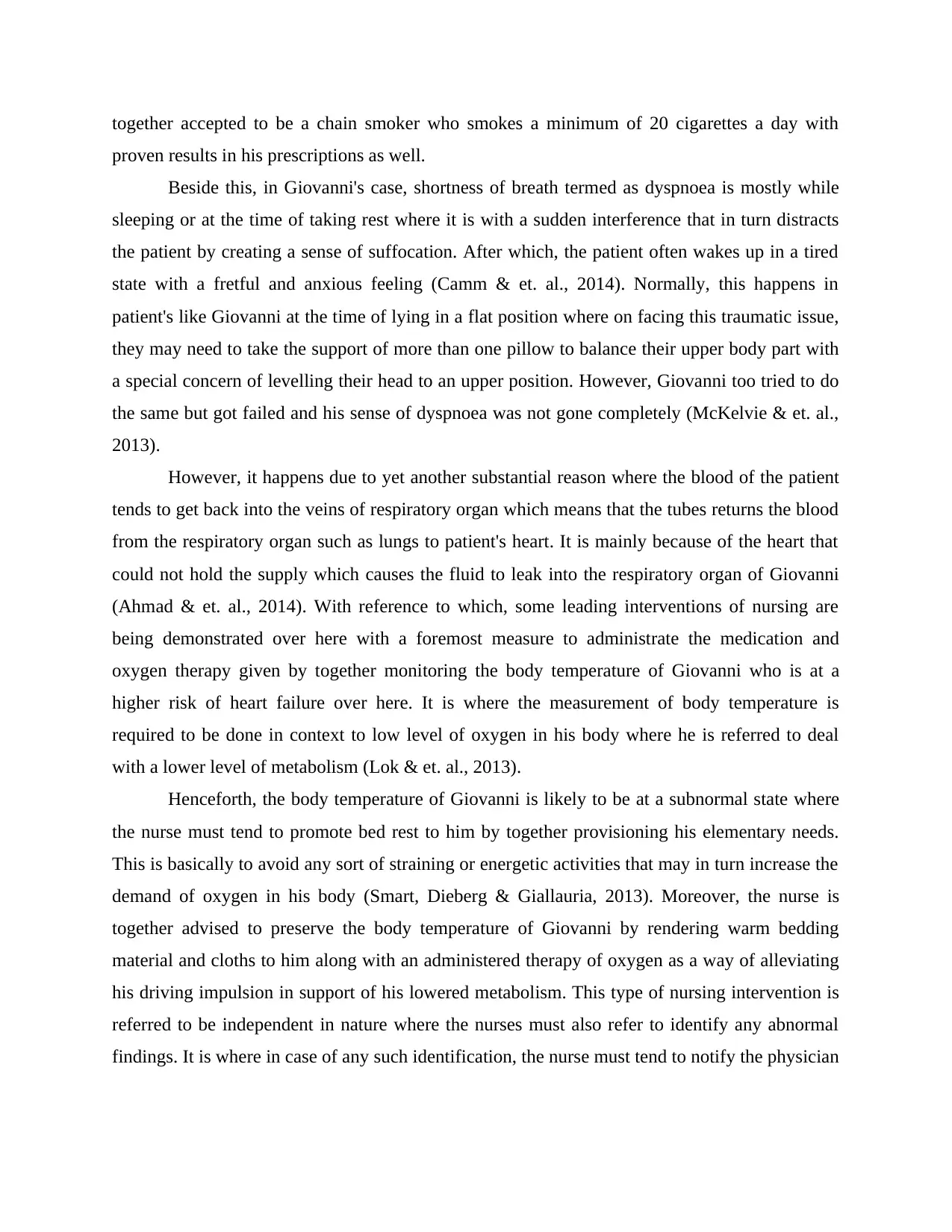
together accepted to be a chain smoker who smokes a minimum of 20 cigarettes a day with
proven results in his prescriptions as well.
Beside this, in Giovanni's case, shortness of breath termed as dyspnoea is mostly while
sleeping or at the time of taking rest where it is with a sudden interference that in turn distracts
the patient by creating a sense of suffocation. After which, the patient often wakes up in a tired
state with a fretful and anxious feeling (Camm & et. al., 2014). Normally, this happens in
patient's like Giovanni at the time of lying in a flat position where on facing this traumatic issue,
they may need to take the support of more than one pillow to balance their upper body part with
a special concern of levelling their head to an upper position. However, Giovanni too tried to do
the same but got failed and his sense of dyspnoea was not gone completely (McKelvie & et. al.,
2013).
However, it happens due to yet another substantial reason where the blood of the patient
tends to get back into the veins of respiratory organ which means that the tubes returns the blood
from the respiratory organ such as lungs to patient's heart. It is mainly because of the heart that
could not hold the supply which causes the fluid to leak into the respiratory organ of Giovanni
(Ahmad & et. al., 2014). With reference to which, some leading interventions of nursing are
being demonstrated over here with a foremost measure to administrate the medication and
oxygen therapy given by together monitoring the body temperature of Giovanni who is at a
higher risk of heart failure over here. It is where the measurement of body temperature is
required to be done in context to low level of oxygen in his body where he is referred to deal
with a lower level of metabolism (Lok & et. al., 2013).
Henceforth, the body temperature of Giovanni is likely to be at a subnormal state where
the nurse must tend to promote bed rest to him by together provisioning his elementary needs.
This is basically to avoid any sort of straining or energetic activities that may in turn increase the
demand of oxygen in his body (Smart, Dieberg & Giallauria, 2013). Moreover, the nurse is
together advised to preserve the body temperature of Giovanni by rendering warm bedding
material and cloths to him along with an administered therapy of oxygen as a way of alleviating
his driving impulsion in support of his lowered metabolism. This type of nursing intervention is
referred to be independent in nature where the nurses must also refer to identify any abnormal
findings. It is where in case of any such identification, the nurse must tend to notify the physician
proven results in his prescriptions as well.
Beside this, in Giovanni's case, shortness of breath termed as dyspnoea is mostly while
sleeping or at the time of taking rest where it is with a sudden interference that in turn distracts
the patient by creating a sense of suffocation. After which, the patient often wakes up in a tired
state with a fretful and anxious feeling (Camm & et. al., 2014). Normally, this happens in
patient's like Giovanni at the time of lying in a flat position where on facing this traumatic issue,
they may need to take the support of more than one pillow to balance their upper body part with
a special concern of levelling their head to an upper position. However, Giovanni too tried to do
the same but got failed and his sense of dyspnoea was not gone completely (McKelvie & et. al.,
2013).
However, it happens due to yet another substantial reason where the blood of the patient
tends to get back into the veins of respiratory organ which means that the tubes returns the blood
from the respiratory organ such as lungs to patient's heart. It is mainly because of the heart that
could not hold the supply which causes the fluid to leak into the respiratory organ of Giovanni
(Ahmad & et. al., 2014). With reference to which, some leading interventions of nursing are
being demonstrated over here with a foremost measure to administrate the medication and
oxygen therapy given by together monitoring the body temperature of Giovanni who is at a
higher risk of heart failure over here. It is where the measurement of body temperature is
required to be done in context to low level of oxygen in his body where he is referred to deal
with a lower level of metabolism (Lok & et. al., 2013).
Henceforth, the body temperature of Giovanni is likely to be at a subnormal state where
the nurse must tend to promote bed rest to him by together provisioning his elementary needs.
This is basically to avoid any sort of straining or energetic activities that may in turn increase the
demand of oxygen in his body (Smart, Dieberg & Giallauria, 2013). Moreover, the nurse is
together advised to preserve the body temperature of Giovanni by rendering warm bedding
material and cloths to him along with an administered therapy of oxygen as a way of alleviating
his driving impulsion in support of his lowered metabolism. This type of nursing intervention is
referred to be independent in nature where the nurses must also refer to identify any abnormal
findings. It is where in case of any such identification, the nurse must tend to notify the physician
Secure Best Marks with AI Grader
Need help grading? Try our AI Grader for instant feedback on your assignments.
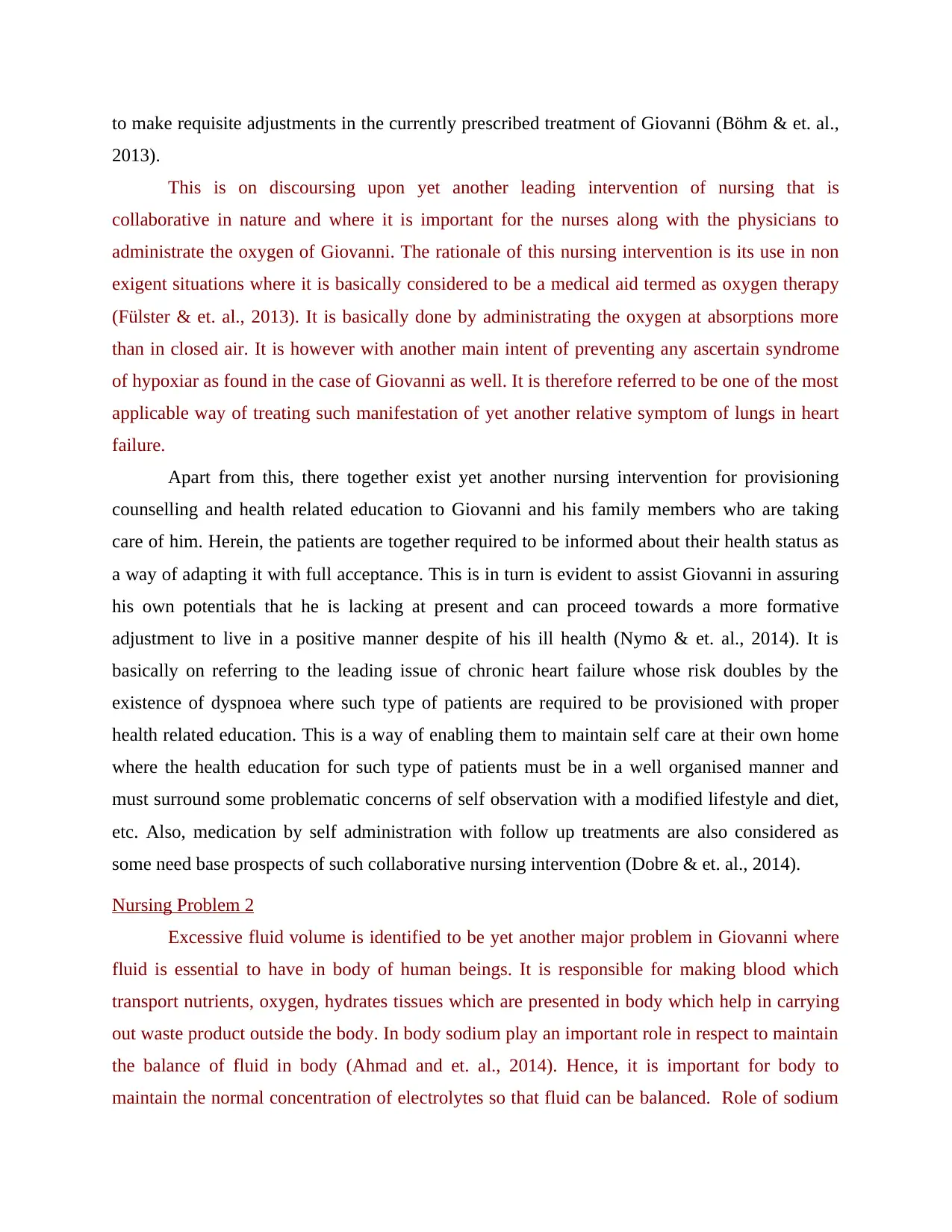
to make requisite adjustments in the currently prescribed treatment of Giovanni (Böhm & et. al.,
2013).
This is on discoursing upon yet another leading intervention of nursing that is
collaborative in nature and where it is important for the nurses along with the physicians to
administrate the oxygen of Giovanni. The rationale of this nursing intervention is its use in non
exigent situations where it is basically considered to be a medical aid termed as oxygen therapy
(Fülster & et. al., 2013). It is basically done by administrating the oxygen at absorptions more
than in closed air. It is however with another main intent of preventing any ascertain syndrome
of hypoxiar as found in the case of Giovanni as well. It is therefore referred to be one of the most
applicable way of treating such manifestation of yet another relative symptom of lungs in heart
failure.
Apart from this, there together exist yet another nursing intervention for provisioning
counselling and health related education to Giovanni and his family members who are taking
care of him. Herein, the patients are together required to be informed about their health status as
a way of adapting it with full acceptance. This is in turn is evident to assist Giovanni in assuring
his own potentials that he is lacking at present and can proceed towards a more formative
adjustment to live in a positive manner despite of his ill health (Nymo & et. al., 2014). It is
basically on referring to the leading issue of chronic heart failure whose risk doubles by the
existence of dyspnoea where such type of patients are required to be provisioned with proper
health related education. This is a way of enabling them to maintain self care at their own home
where the health education for such type of patients must be in a well organised manner and
must surround some problematic concerns of self observation with a modified lifestyle and diet,
etc. Also, medication by self administration with follow up treatments are also considered as
some need base prospects of such collaborative nursing intervention (Dobre & et. al., 2014).
Nursing Problem 2
Excessive fluid volume is identified to be yet another major problem in Giovanni where
fluid is essential to have in body of human beings. It is responsible for making blood which
transport nutrients, oxygen, hydrates tissues which are presented in body which help in carrying
out waste product outside the body. In body sodium play an important role in respect to maintain
the balance of fluid in body (Ahmad and et. al., 2014). Hence, it is important for body to
maintain the normal concentration of electrolytes so that fluid can be balanced. Role of sodium
2013).
This is on discoursing upon yet another leading intervention of nursing that is
collaborative in nature and where it is important for the nurses along with the physicians to
administrate the oxygen of Giovanni. The rationale of this nursing intervention is its use in non
exigent situations where it is basically considered to be a medical aid termed as oxygen therapy
(Fülster & et. al., 2013). It is basically done by administrating the oxygen at absorptions more
than in closed air. It is however with another main intent of preventing any ascertain syndrome
of hypoxiar as found in the case of Giovanni as well. It is therefore referred to be one of the most
applicable way of treating such manifestation of yet another relative symptom of lungs in heart
failure.
Apart from this, there together exist yet another nursing intervention for provisioning
counselling and health related education to Giovanni and his family members who are taking
care of him. Herein, the patients are together required to be informed about their health status as
a way of adapting it with full acceptance. This is in turn is evident to assist Giovanni in assuring
his own potentials that he is lacking at present and can proceed towards a more formative
adjustment to live in a positive manner despite of his ill health (Nymo & et. al., 2014). It is
basically on referring to the leading issue of chronic heart failure whose risk doubles by the
existence of dyspnoea where such type of patients are required to be provisioned with proper
health related education. This is a way of enabling them to maintain self care at their own home
where the health education for such type of patients must be in a well organised manner and
must surround some problematic concerns of self observation with a modified lifestyle and diet,
etc. Also, medication by self administration with follow up treatments are also considered as
some need base prospects of such collaborative nursing intervention (Dobre & et. al., 2014).
Nursing Problem 2
Excessive fluid volume is identified to be yet another major problem in Giovanni where
fluid is essential to have in body of human beings. It is responsible for making blood which
transport nutrients, oxygen, hydrates tissues which are presented in body which help in carrying
out waste product outside the body. In body sodium play an important role in respect to maintain
the balance of fluid in body (Ahmad and et. al., 2014). Hence, it is important for body to
maintain the normal concentration of electrolytes so that fluid can be balanced. Role of sodium
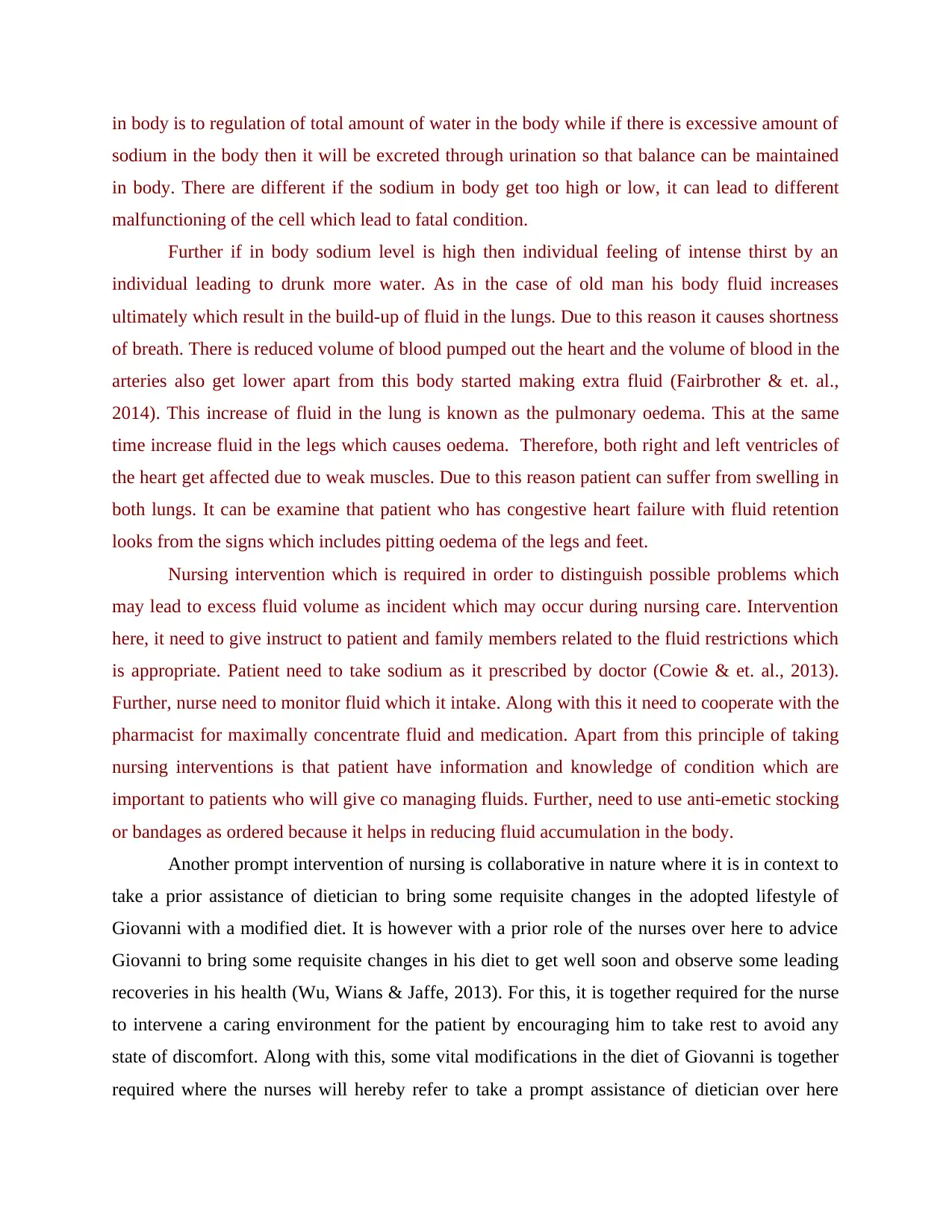
in body is to regulation of total amount of water in the body while if there is excessive amount of
sodium in the body then it will be excreted through urination so that balance can be maintained
in body. There are different if the sodium in body get too high or low, it can lead to different
malfunctioning of the cell which lead to fatal condition.
Further if in body sodium level is high then individual feeling of intense thirst by an
individual leading to drunk more water. As in the case of old man his body fluid increases
ultimately which result in the build-up of fluid in the lungs. Due to this reason it causes shortness
of breath. There is reduced volume of blood pumped out the heart and the volume of blood in the
arteries also get lower apart from this body started making extra fluid (Fairbrother & et. al.,
2014). This increase of fluid in the lung is known as the pulmonary oedema. This at the same
time increase fluid in the legs which causes oedema. Therefore, both right and left ventricles of
the heart get affected due to weak muscles. Due to this reason patient can suffer from swelling in
both lungs. It can be examine that patient who has congestive heart failure with fluid retention
looks from the signs which includes pitting oedema of the legs and feet.
Nursing intervention which is required in order to distinguish possible problems which
may lead to excess fluid volume as incident which may occur during nursing care. Intervention
here, it need to give instruct to patient and family members related to the fluid restrictions which
is appropriate. Patient need to take sodium as it prescribed by doctor (Cowie & et. al., 2013).
Further, nurse need to monitor fluid which it intake. Along with this it need to cooperate with the
pharmacist for maximally concentrate fluid and medication. Apart from this principle of taking
nursing interventions is that patient have information and knowledge of condition which are
important to patients who will give co managing fluids. Further, need to use anti-emetic stocking
or bandages as ordered because it helps in reducing fluid accumulation in the body.
Another prompt intervention of nursing is collaborative in nature where it is in context to
take a prior assistance of dietician to bring some requisite changes in the adopted lifestyle of
Giovanni with a modified diet. It is however with a prior role of the nurses over here to advice
Giovanni to bring some requisite changes in his diet to get well soon and observe some leading
recoveries in his health (Wu, Wians & Jaffe, 2013). For this, it is together required for the nurse
to intervene a caring environment for the patient by encouraging him to take rest to avoid any
state of discomfort. Along with this, some vital modifications in the diet of Giovanni is together
required where the nurses will hereby refer to take a prompt assistance of dietician over here
sodium in the body then it will be excreted through urination so that balance can be maintained
in body. There are different if the sodium in body get too high or low, it can lead to different
malfunctioning of the cell which lead to fatal condition.
Further if in body sodium level is high then individual feeling of intense thirst by an
individual leading to drunk more water. As in the case of old man his body fluid increases
ultimately which result in the build-up of fluid in the lungs. Due to this reason it causes shortness
of breath. There is reduced volume of blood pumped out the heart and the volume of blood in the
arteries also get lower apart from this body started making extra fluid (Fairbrother & et. al.,
2014). This increase of fluid in the lung is known as the pulmonary oedema. This at the same
time increase fluid in the legs which causes oedema. Therefore, both right and left ventricles of
the heart get affected due to weak muscles. Due to this reason patient can suffer from swelling in
both lungs. It can be examine that patient who has congestive heart failure with fluid retention
looks from the signs which includes pitting oedema of the legs and feet.
Nursing intervention which is required in order to distinguish possible problems which
may lead to excess fluid volume as incident which may occur during nursing care. Intervention
here, it need to give instruct to patient and family members related to the fluid restrictions which
is appropriate. Patient need to take sodium as it prescribed by doctor (Cowie & et. al., 2013).
Further, nurse need to monitor fluid which it intake. Along with this it need to cooperate with the
pharmacist for maximally concentrate fluid and medication. Apart from this principle of taking
nursing interventions is that patient have information and knowledge of condition which are
important to patients who will give co managing fluids. Further, need to use anti-emetic stocking
or bandages as ordered because it helps in reducing fluid accumulation in the body.
Another prompt intervention of nursing is collaborative in nature where it is in context to
take a prior assistance of dietician to bring some requisite changes in the adopted lifestyle of
Giovanni with a modified diet. It is however with a prior role of the nurses over here to advice
Giovanni to bring some requisite changes in his diet to get well soon and observe some leading
recoveries in his health (Wu, Wians & Jaffe, 2013). For this, it is together required for the nurse
to intervene a caring environment for the patient by encouraging him to take rest to avoid any
state of discomfort. Along with this, some vital modifications in the diet of Giovanni is together
required where the nurses will hereby refer to take a prompt assistance of dietician over here
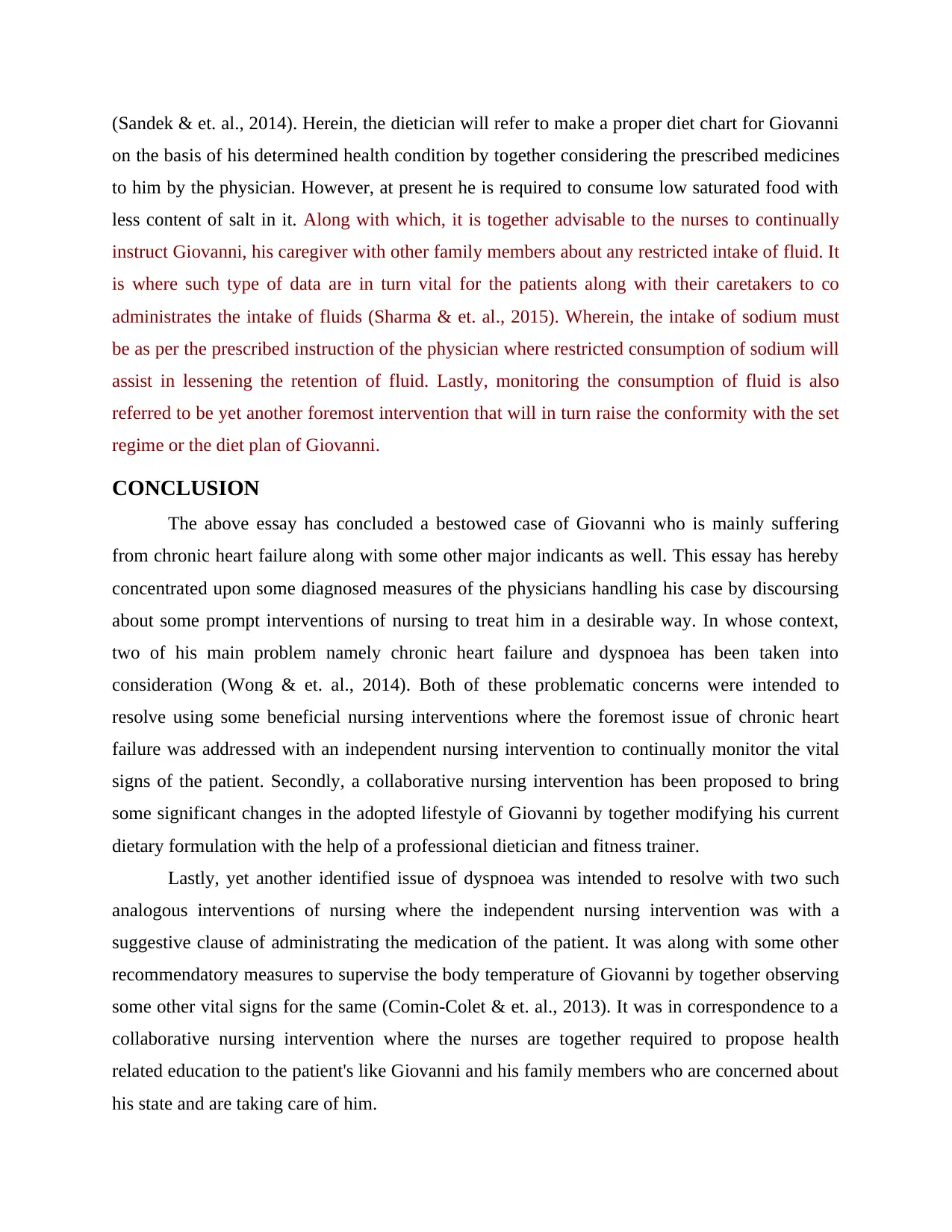
(Sandek & et. al., 2014). Herein, the dietician will refer to make a proper diet chart for Giovanni
on the basis of his determined health condition by together considering the prescribed medicines
to him by the physician. However, at present he is required to consume low saturated food with
less content of salt in it. Along with which, it is together advisable to the nurses to continually
instruct Giovanni, his caregiver with other family members about any restricted intake of fluid. It
is where such type of data are in turn vital for the patients along with their caretakers to co
administrates the intake of fluids (Sharma & et. al., 2015). Wherein, the intake of sodium must
be as per the prescribed instruction of the physician where restricted consumption of sodium will
assist in lessening the retention of fluid. Lastly, monitoring the consumption of fluid is also
referred to be yet another foremost intervention that will in turn raise the conformity with the set
regime or the diet plan of Giovanni.
CONCLUSION
The above essay has concluded a bestowed case of Giovanni who is mainly suffering
from chronic heart failure along with some other major indicants as well. This essay has hereby
concentrated upon some diagnosed measures of the physicians handling his case by discoursing
about some prompt interventions of nursing to treat him in a desirable way. In whose context,
two of his main problem namely chronic heart failure and dyspnoea has been taken into
consideration (Wong & et. al., 2014). Both of these problematic concerns were intended to
resolve using some beneficial nursing interventions where the foremost issue of chronic heart
failure was addressed with an independent nursing intervention to continually monitor the vital
signs of the patient. Secondly, a collaborative nursing intervention has been proposed to bring
some significant changes in the adopted lifestyle of Giovanni by together modifying his current
dietary formulation with the help of a professional dietician and fitness trainer.
Lastly, yet another identified issue of dyspnoea was intended to resolve with two such
analogous interventions of nursing where the independent nursing intervention was with a
suggestive clause of administrating the medication of the patient. It was along with some other
recommendatory measures to supervise the body temperature of Giovanni by together observing
some other vital signs for the same (Comin-Colet & et. al., 2013). It was in correspondence to a
collaborative nursing intervention where the nurses are together required to propose health
related education to the patient's like Giovanni and his family members who are concerned about
his state and are taking care of him.
on the basis of his determined health condition by together considering the prescribed medicines
to him by the physician. However, at present he is required to consume low saturated food with
less content of salt in it. Along with which, it is together advisable to the nurses to continually
instruct Giovanni, his caregiver with other family members about any restricted intake of fluid. It
is where such type of data are in turn vital for the patients along with their caretakers to co
administrates the intake of fluids (Sharma & et. al., 2015). Wherein, the intake of sodium must
be as per the prescribed instruction of the physician where restricted consumption of sodium will
assist in lessening the retention of fluid. Lastly, monitoring the consumption of fluid is also
referred to be yet another foremost intervention that will in turn raise the conformity with the set
regime or the diet plan of Giovanni.
CONCLUSION
The above essay has concluded a bestowed case of Giovanni who is mainly suffering
from chronic heart failure along with some other major indicants as well. This essay has hereby
concentrated upon some diagnosed measures of the physicians handling his case by discoursing
about some prompt interventions of nursing to treat him in a desirable way. In whose context,
two of his main problem namely chronic heart failure and dyspnoea has been taken into
consideration (Wong & et. al., 2014). Both of these problematic concerns were intended to
resolve using some beneficial nursing interventions where the foremost issue of chronic heart
failure was addressed with an independent nursing intervention to continually monitor the vital
signs of the patient. Secondly, a collaborative nursing intervention has been proposed to bring
some significant changes in the adopted lifestyle of Giovanni by together modifying his current
dietary formulation with the help of a professional dietician and fitness trainer.
Lastly, yet another identified issue of dyspnoea was intended to resolve with two such
analogous interventions of nursing where the independent nursing intervention was with a
suggestive clause of administrating the medication of the patient. It was along with some other
recommendatory measures to supervise the body temperature of Giovanni by together observing
some other vital signs for the same (Comin-Colet & et. al., 2013). It was in correspondence to a
collaborative nursing intervention where the nurses are together required to propose health
related education to the patient's like Giovanni and his family members who are concerned about
his state and are taking care of him.
Paraphrase This Document
Need a fresh take? Get an instant paraphrase of this document with our AI Paraphraser
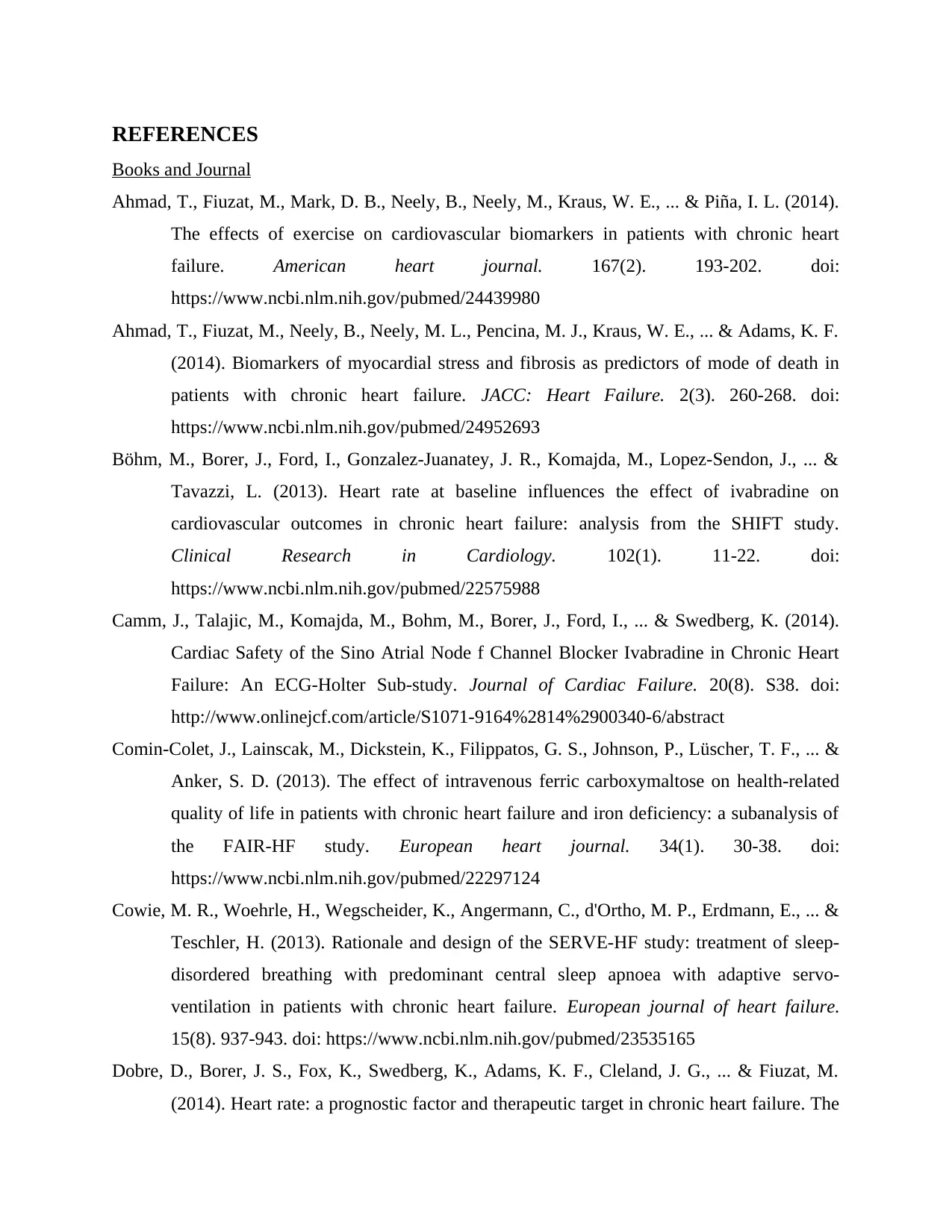
REFERENCES
Books and Journal
Ahmad, T., Fiuzat, M., Mark, D. B., Neely, B., Neely, M., Kraus, W. E., ... & Piña, I. L. (2014).
The effects of exercise on cardiovascular biomarkers in patients with chronic heart
failure. American heart journal. 167(2). 193-202. doi:
https://www.ncbi.nlm.nih.gov/pubmed/24439980
Ahmad, T., Fiuzat, M., Neely, B., Neely, M. L., Pencina, M. J., Kraus, W. E., ... & Adams, K. F.
(2014). Biomarkers of myocardial stress and fibrosis as predictors of mode of death in
patients with chronic heart failure. JACC: Heart Failure. 2(3). 260-268. doi:
https://www.ncbi.nlm.nih.gov/pubmed/24952693
Böhm, M., Borer, J., Ford, I., Gonzalez-Juanatey, J. R., Komajda, M., Lopez-Sendon, J., ... &
Tavazzi, L. (2013). Heart rate at baseline influences the effect of ivabradine on
cardiovascular outcomes in chronic heart failure: analysis from the SHIFT study.
Clinical Research in Cardiology. 102(1). 11-22. doi:
https://www.ncbi.nlm.nih.gov/pubmed/22575988
Camm, J., Talajic, M., Komajda, M., Bohm, M., Borer, J., Ford, I., ... & Swedberg, K. (2014).
Cardiac Safety of the Sino Atrial Node f Channel Blocker Ivabradine in Chronic Heart
Failure: An ECG-Holter Sub-study. Journal of Cardiac Failure. 20(8). S38. doi:
http://www.onlinejcf.com/article/S1071-9164%2814%2900340-6/abstract
Comin-Colet, J., Lainscak, M., Dickstein, K., Filippatos, G. S., Johnson, P., Lüscher, T. F., ... &
Anker, S. D. (2013). The effect of intravenous ferric carboxymaltose on health-related
quality of life in patients with chronic heart failure and iron deficiency: a subanalysis of
the FAIR-HF study. European heart journal. 34(1). 30-38. doi:
https://www.ncbi.nlm.nih.gov/pubmed/22297124
Cowie, M. R., Woehrle, H., Wegscheider, K., Angermann, C., d'Ortho, M. P., Erdmann, E., ... &
Teschler, H. (2013). Rationale and design of the SERVE‐HF study: treatment of sleep‐
disordered breathing with predominant central sleep apnoea with adaptive servo‐
ventilation in patients with chronic heart failure. European journal of heart failure.
15(8). 937-943. doi: https://www.ncbi.nlm.nih.gov/pubmed/23535165
Dobre, D., Borer, J. S., Fox, K., Swedberg, K., Adams, K. F., Cleland, J. G., ... & Fiuzat, M.
(2014). Heart rate: a prognostic factor and therapeutic target in chronic heart failure. The
Books and Journal
Ahmad, T., Fiuzat, M., Mark, D. B., Neely, B., Neely, M., Kraus, W. E., ... & Piña, I. L. (2014).
The effects of exercise on cardiovascular biomarkers in patients with chronic heart
failure. American heart journal. 167(2). 193-202. doi:
https://www.ncbi.nlm.nih.gov/pubmed/24439980
Ahmad, T., Fiuzat, M., Neely, B., Neely, M. L., Pencina, M. J., Kraus, W. E., ... & Adams, K. F.
(2014). Biomarkers of myocardial stress and fibrosis as predictors of mode of death in
patients with chronic heart failure. JACC: Heart Failure. 2(3). 260-268. doi:
https://www.ncbi.nlm.nih.gov/pubmed/24952693
Böhm, M., Borer, J., Ford, I., Gonzalez-Juanatey, J. R., Komajda, M., Lopez-Sendon, J., ... &
Tavazzi, L. (2013). Heart rate at baseline influences the effect of ivabradine on
cardiovascular outcomes in chronic heart failure: analysis from the SHIFT study.
Clinical Research in Cardiology. 102(1). 11-22. doi:
https://www.ncbi.nlm.nih.gov/pubmed/22575988
Camm, J., Talajic, M., Komajda, M., Bohm, M., Borer, J., Ford, I., ... & Swedberg, K. (2014).
Cardiac Safety of the Sino Atrial Node f Channel Blocker Ivabradine in Chronic Heart
Failure: An ECG-Holter Sub-study. Journal of Cardiac Failure. 20(8). S38. doi:
http://www.onlinejcf.com/article/S1071-9164%2814%2900340-6/abstract
Comin-Colet, J., Lainscak, M., Dickstein, K., Filippatos, G. S., Johnson, P., Lüscher, T. F., ... &
Anker, S. D. (2013). The effect of intravenous ferric carboxymaltose on health-related
quality of life in patients with chronic heart failure and iron deficiency: a subanalysis of
the FAIR-HF study. European heart journal. 34(1). 30-38. doi:
https://www.ncbi.nlm.nih.gov/pubmed/22297124
Cowie, M. R., Woehrle, H., Wegscheider, K., Angermann, C., d'Ortho, M. P., Erdmann, E., ... &
Teschler, H. (2013). Rationale and design of the SERVE‐HF study: treatment of sleep‐
disordered breathing with predominant central sleep apnoea with adaptive servo‐
ventilation in patients with chronic heart failure. European journal of heart failure.
15(8). 937-943. doi: https://www.ncbi.nlm.nih.gov/pubmed/23535165
Dobre, D., Borer, J. S., Fox, K., Swedberg, K., Adams, K. F., Cleland, J. G., ... & Fiuzat, M.
(2014). Heart rate: a prognostic factor and therapeutic target in chronic heart failure. The
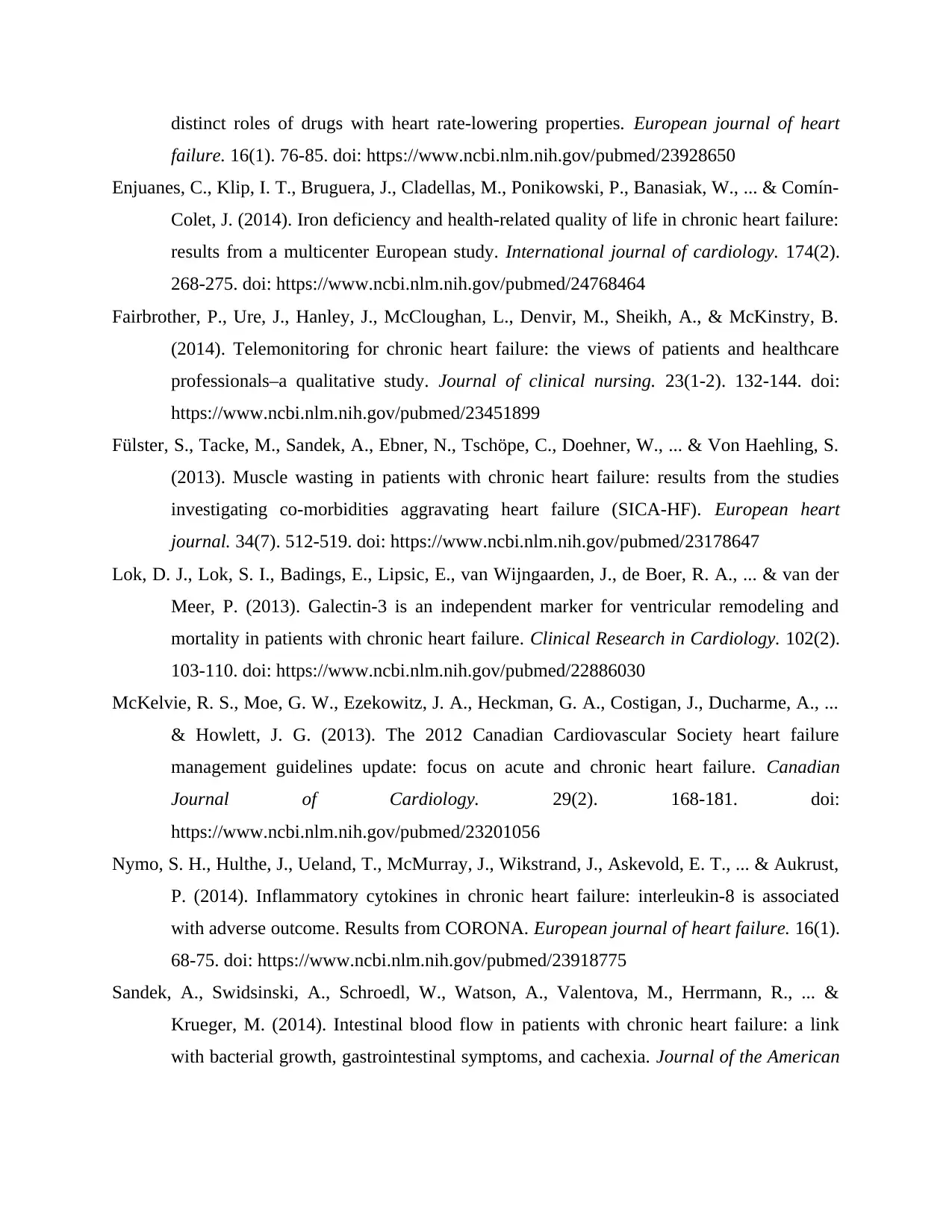
distinct roles of drugs with heart rate‐lowering properties. European journal of heart
failure. 16(1). 76-85. doi: https://www.ncbi.nlm.nih.gov/pubmed/23928650
Enjuanes, C., Klip, I. T., Bruguera, J., Cladellas, M., Ponikowski, P., Banasiak, W., ... & Comín-
Colet, J. (2014). Iron deficiency and health-related quality of life in chronic heart failure:
results from a multicenter European study. International journal of cardiology. 174(2).
268-275. doi: https://www.ncbi.nlm.nih.gov/pubmed/24768464
Fairbrother, P., Ure, J., Hanley, J., McCloughan, L., Denvir, M., Sheikh, A., & McKinstry, B.
(2014). Telemonitoring for chronic heart failure: the views of patients and healthcare
professionals–a qualitative study. Journal of clinical nursing. 23(1-2). 132-144. doi:
https://www.ncbi.nlm.nih.gov/pubmed/23451899
Fülster, S., Tacke, M., Sandek, A., Ebner, N., Tschöpe, C., Doehner, W., ... & Von Haehling, S.
(2013). Muscle wasting in patients with chronic heart failure: results from the studies
investigating co-morbidities aggravating heart failure (SICA-HF). European heart
journal. 34(7). 512-519. doi: https://www.ncbi.nlm.nih.gov/pubmed/23178647
Lok, D. J., Lok, S. I., Badings, E., Lipsic, E., van Wijngaarden, J., de Boer, R. A., ... & van der
Meer, P. (2013). Galectin-3 is an independent marker for ventricular remodeling and
mortality in patients with chronic heart failure. Clinical Research in Cardiology. 102(2).
103-110. doi: https://www.ncbi.nlm.nih.gov/pubmed/22886030
McKelvie, R. S., Moe, G. W., Ezekowitz, J. A., Heckman, G. A., Costigan, J., Ducharme, A., ...
& Howlett, J. G. (2013). The 2012 Canadian Cardiovascular Society heart failure
management guidelines update: focus on acute and chronic heart failure. Canadian
Journal of Cardiology. 29(2). 168-181. doi:
https://www.ncbi.nlm.nih.gov/pubmed/23201056
Nymo, S. H., Hulthe, J., Ueland, T., McMurray, J., Wikstrand, J., Askevold, E. T., ... & Aukrust,
P. (2014). Inflammatory cytokines in chronic heart failure: interleukin‐8 is associated
with adverse outcome. Results from CORONA. European journal of heart failure. 16(1).
68-75. doi: https://www.ncbi.nlm.nih.gov/pubmed/23918775
Sandek, A., Swidsinski, A., Schroedl, W., Watson, A., Valentova, M., Herrmann, R., ... &
Krueger, M. (2014). Intestinal blood flow in patients with chronic heart failure: a link
with bacterial growth, gastrointestinal symptoms, and cachexia. Journal of the American
failure. 16(1). 76-85. doi: https://www.ncbi.nlm.nih.gov/pubmed/23928650
Enjuanes, C., Klip, I. T., Bruguera, J., Cladellas, M., Ponikowski, P., Banasiak, W., ... & Comín-
Colet, J. (2014). Iron deficiency and health-related quality of life in chronic heart failure:
results from a multicenter European study. International journal of cardiology. 174(2).
268-275. doi: https://www.ncbi.nlm.nih.gov/pubmed/24768464
Fairbrother, P., Ure, J., Hanley, J., McCloughan, L., Denvir, M., Sheikh, A., & McKinstry, B.
(2014). Telemonitoring for chronic heart failure: the views of patients and healthcare
professionals–a qualitative study. Journal of clinical nursing. 23(1-2). 132-144. doi:
https://www.ncbi.nlm.nih.gov/pubmed/23451899
Fülster, S., Tacke, M., Sandek, A., Ebner, N., Tschöpe, C., Doehner, W., ... & Von Haehling, S.
(2013). Muscle wasting in patients with chronic heart failure: results from the studies
investigating co-morbidities aggravating heart failure (SICA-HF). European heart
journal. 34(7). 512-519. doi: https://www.ncbi.nlm.nih.gov/pubmed/23178647
Lok, D. J., Lok, S. I., Badings, E., Lipsic, E., van Wijngaarden, J., de Boer, R. A., ... & van der
Meer, P. (2013). Galectin-3 is an independent marker for ventricular remodeling and
mortality in patients with chronic heart failure. Clinical Research in Cardiology. 102(2).
103-110. doi: https://www.ncbi.nlm.nih.gov/pubmed/22886030
McKelvie, R. S., Moe, G. W., Ezekowitz, J. A., Heckman, G. A., Costigan, J., Ducharme, A., ...
& Howlett, J. G. (2013). The 2012 Canadian Cardiovascular Society heart failure
management guidelines update: focus on acute and chronic heart failure. Canadian
Journal of Cardiology. 29(2). 168-181. doi:
https://www.ncbi.nlm.nih.gov/pubmed/23201056
Nymo, S. H., Hulthe, J., Ueland, T., McMurray, J., Wikstrand, J., Askevold, E. T., ... & Aukrust,
P. (2014). Inflammatory cytokines in chronic heart failure: interleukin‐8 is associated
with adverse outcome. Results from CORONA. European journal of heart failure. 16(1).
68-75. doi: https://www.ncbi.nlm.nih.gov/pubmed/23918775
Sandek, A., Swidsinski, A., Schroedl, W., Watson, A., Valentova, M., Herrmann, R., ... &
Krueger, M. (2014). Intestinal blood flow in patients with chronic heart failure: a link
with bacterial growth, gastrointestinal symptoms, and cachexia. Journal of the American

College of Cardiology. 64(11). 1092-1102. doi:
https://www.ncbi.nlm.nih.gov/pubmed/25212642
Sandri, M., Viehmann, M., Adams, V., Rabald, K., Mangner, N., Höllriegel, R., ... & Möbius-
Winkler, S. (2016). Chronic heart failure and aging–effects of exercise training on
endothelial function and mechanisms of endothelial regeneration: Results from the
Leipzig Exercise Intervention in Chronic heart failure and Aging (LEICA) study.
European journal of preventive cardiology. 23(4). 349-358. doi:
https://www.ncbi.nlm.nih.gov/pubmed/26015451
Sharma, A., Lavie, C. J., Borer, J. S., Vallakati, A., Goel, S., Lopez-Jimenez, F., ... & Lazar, J.
M. (2015). Meta-analysis of the relation of body mass index to all-cause and
cardiovascular mortality and hospitalization in patients with chronic heart failure. The
American journal of cardiology. 115(10). 1428-1434. doi:
https://www.ncbi.nlm.nih.gov/pubmed/25772740
Smart, N. A., Dieberg, G., & Giallauria, F. (2013). Intermittent versus continuous exercise
training in chronic heart failure: a meta-analysis. International journal of cardiology.
166(2). 352-358. doi: https://www.ncbi.nlm.nih.gov/pubmed/22100179
Wong, C. M., Hawkins, N. M., Petrie, M. C., Jhund, P. S., Gardner, R. S., Ariti, C. A., ... &
Doughty, R. N. (2014). Heart failure in younger patients: the Meta-analysis Global
Group in Chronic Heart Failure (MAGGIC). European heart journal. 35(39). 2714-2721.
Wu, A. H., Wians, F., & Jaffe, A. (2013). Biological variation of galectin-3 and soluble ST2 for
chronic heart failure: implication on interpretation of test results. American heart
journal. 165(6). 995-999. doi: https://www.ncbi.nlm.nih.gov/pubmed/23708172
Zannad, F., De Ferrari, G. M., Tuinenburg, A. E., Wright, D., Brugada, J., Butter, C., ... &
Ramuzat, A. (2015). Chronic vagal stimulation for the treatment of low ejection fraction
heart failure: results of the NEural Cardiac TherApy foR Heart Failure (NECTAR-HF)
randomized controlled trial. European heart journal. 36(7). 425-433. doi:
https://www.academic.oup.com/eurheartj/article/36/7/425/2293442/Chronic-vagal-
stimulation-for-the-treatment-of-low
https://www.ncbi.nlm.nih.gov/pubmed/25212642
Sandri, M., Viehmann, M., Adams, V., Rabald, K., Mangner, N., Höllriegel, R., ... & Möbius-
Winkler, S. (2016). Chronic heart failure and aging–effects of exercise training on
endothelial function and mechanisms of endothelial regeneration: Results from the
Leipzig Exercise Intervention in Chronic heart failure and Aging (LEICA) study.
European journal of preventive cardiology. 23(4). 349-358. doi:
https://www.ncbi.nlm.nih.gov/pubmed/26015451
Sharma, A., Lavie, C. J., Borer, J. S., Vallakati, A., Goel, S., Lopez-Jimenez, F., ... & Lazar, J.
M. (2015). Meta-analysis of the relation of body mass index to all-cause and
cardiovascular mortality and hospitalization in patients with chronic heart failure. The
American journal of cardiology. 115(10). 1428-1434. doi:
https://www.ncbi.nlm.nih.gov/pubmed/25772740
Smart, N. A., Dieberg, G., & Giallauria, F. (2013). Intermittent versus continuous exercise
training in chronic heart failure: a meta-analysis. International journal of cardiology.
166(2). 352-358. doi: https://www.ncbi.nlm.nih.gov/pubmed/22100179
Wong, C. M., Hawkins, N. M., Petrie, M. C., Jhund, P. S., Gardner, R. S., Ariti, C. A., ... &
Doughty, R. N. (2014). Heart failure in younger patients: the Meta-analysis Global
Group in Chronic Heart Failure (MAGGIC). European heart journal. 35(39). 2714-2721.
Wu, A. H., Wians, F., & Jaffe, A. (2013). Biological variation of galectin-3 and soluble ST2 for
chronic heart failure: implication on interpretation of test results. American heart
journal. 165(6). 995-999. doi: https://www.ncbi.nlm.nih.gov/pubmed/23708172
Zannad, F., De Ferrari, G. M., Tuinenburg, A. E., Wright, D., Brugada, J., Butter, C., ... &
Ramuzat, A. (2015). Chronic vagal stimulation for the treatment of low ejection fraction
heart failure: results of the NEural Cardiac TherApy foR Heart Failure (NECTAR-HF)
randomized controlled trial. European heart journal. 36(7). 425-433. doi:
https://www.academic.oup.com/eurheartj/article/36/7/425/2293442/Chronic-vagal-
stimulation-for-the-treatment-of-low
Secure Best Marks with AI Grader
Need help grading? Try our AI Grader for instant feedback on your assignments.

1

2

3
Paraphrase This Document
Need a fresh take? Get an instant paraphrase of this document with our AI Paraphraser

4
1 out of 14
Related Documents
Your All-in-One AI-Powered Toolkit for Academic Success.
+13062052269
info@desklib.com
Available 24*7 on WhatsApp / Email
![[object Object]](/_next/static/media/star-bottom.7253800d.svg)
Unlock your academic potential
© 2024 | Zucol Services PVT LTD | All rights reserved.





